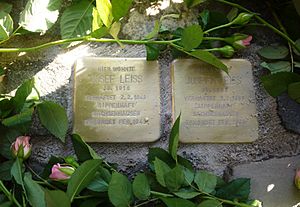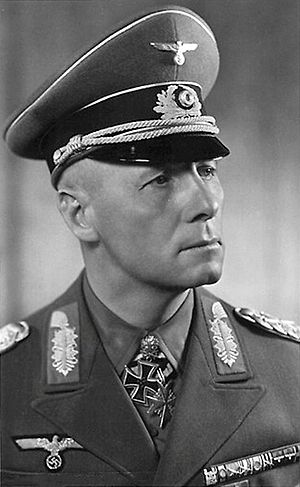Sippenhaft facts for kids
Sippenhaft is a German word. It means that a whole family or group of relatives could be held responsible for something one family member did. This idea was used to punish an entire family for one person's actions.
In the past, especially during the Middle Ages, this idea came from old Germanic law. Families might have to pay money or other forms of payment if one of their members committed a crime.
Later, in Nazi Germany, the idea of Sippenhaft was used again. It was used to punish the family members of people who were seen as enemies of the state. This often meant relatives were arrested or even killed. A famous example is how families of those involved in the 20 July plot, a plan to kill Adolf Hitler in 1944, were punished.
Contents
How Sippenhaft Started
Before Roman law and Christianity became common, Sippenhaft was an important idea among Germanic people. This included groups like the Anglo-Saxons and people in Scandinavia.
Old Germanic laws had two main ways to deal with serious crimes like murder. One was blood revenge, where a family might try to get even. The other was blood money. This was a payment made to the victim's family instead of revenge. The amount of money, called weregild, depended on the victim's importance.
The idea of Sippenhaft meant that not just the person who committed the crime, but their whole family, could face revenge or have to pay this money. Similar ideas were also found among other ancient groups like the Celts and Slavs.
Sippenhaft in Nazi Germany
In Nazi Germany, the term Sippenhaft was brought back. It was used to justify punishing the relatives of someone who had committed a crime against the state. This meant that family members were seen as sharing the blame. They could be arrested and sometimes even put to death.




The German army, known as the Wehrmacht, started using threats of Sippenhaft around 1943. Soldiers who were thought to have "blood impurities" or those from outside Germany were especially threatened. Their families could be punished.
For example, a soldier named Wenzeslaus Leiss was accused of leaving his post in December 1942. The secret police, called the Gestapo, found out his family might have Polish connections. In February 1943, his wife, young daughter, two brothers, sister, and brother-in-law were all arrested. They were later killed at Sachsenhausen concentration camp.
By 1944, many orders were given to soldiers. These orders threatened their families with punishment if the soldiers did not follow rules.
Punishment After the 20 July Plot
Many people who had done nothing wrong were arrested after the failed 20 July plot. This was a plan to kill Adolf Hitler in July 1944. After the plot failed, the SS chief, Heinrich Himmler, spoke about "absolute responsibility of kin." He said this was a very old custom.
Himmler claimed that in ancient times, if a family member committed treason, the whole family would be "wiped out." He said that Claus von Stauffenberg's family would also be wiped out. Stauffenberg was the officer who planted the bomb that failed to kill Hitler.
Because of this, all members of von Stauffenberg's family were suspected. His wife, Nina Schenk Gräfin von Stauffenberg, was sent to Ravensbrück concentration camp. She survived the war. His brother Alexander, who knew nothing about the plot, was also sent to a concentration camp. Similar punishments happened to the families of many other people involved in the plot.
After the 20 July plot, families connected to the League of German Officers were also arrested. This group was made up of German prisoners of war. Unlike some of the 20 July plotters' families, these families stayed in prison until the end of the war. Younger children of arrested plotters were not jailed. Instead, they were sent to orphanages and given new names. For example, Stauffenberg's children were renamed "Meister."
These threats also extended to all German troops and commanders. In February 1945, a rule was made that threatened death to the relatives of military commanders. This would happen if the commanders showed what Hitler called "cowardice." After the city of Königsberg surrendered in April 1945, the family of General Otto Lasch was arrested. These arrests were even announced in the newspaper.
Sippenhaft Today
Today, the idea of Sippenhaft is not allowed under German Basic Law. This means it has no legal meaning or power in Germany.
Modern Examples
In a report from September 2021, the Independent International Fact-Finding Mission on Venezuela found something similar. It said that security agents in Venezuela reportedly used methods like Sippenhaft. They would kidnap and hold relatives of people who criticized the government. This was done to force arrests.
See also
- Association fallacy
- Family members of traitors to the Motherland – how kin punishment was used in Soviet Russia
- Gjakmarrja
- Lidice massacre
- Nine familial exterminations – kin punishment in ancient China
- Glossary of Nazi Germany

